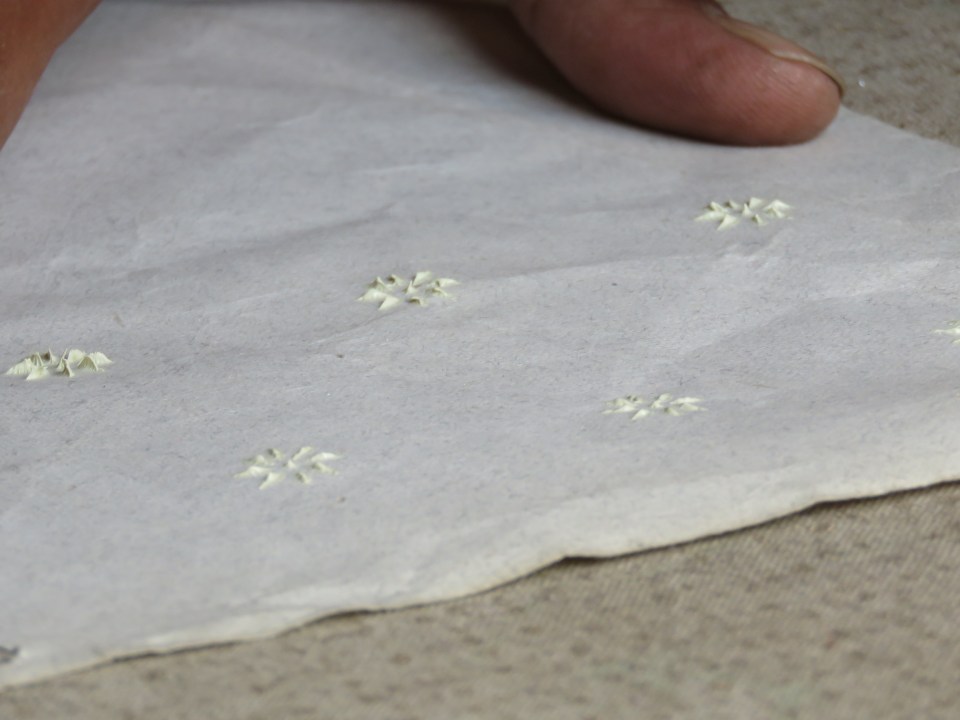
The art of Rogan block printing
We were in Ahmedabad and my friend Deepa asked us if we would like to see the craft of Rogan block printing. So we hired two auto rickshaws and went off to find Khan Chowk. After some hits and misses, we reached our destination. We found a group of women chatting by the road, and when we asked them where we could see Rogan art, we were directed to the house where sarees were spread out for drying. This particular house turned out to be a dilapidated structure where Anees, the craftsman lived.
I gingerly climbed up three steep rickety staircases with trepidation. The women and the children of the house regarded my huffing and puffing with amusement. But it was worth the climb. On the roof terrace, we met Anees who was waiting for us. Anees is an artisan who comes from a long generation of craftsmen. It was a Sunday and most workmen were away. But he demonstrated the craft of Rogan to us.
The history of Rogan art
The word ‘Rogan’ is derived from a Persian word meaning ‘varnish’ or ‘oil’. The art originating in Persia was brought to India by the Khatri community. This is a Muslim community which arrived in India from Sindh in Pakistan. Traditionally Rogan was a seasonal craft which was performed only before the wedding season. Rogan art was used to embellish the wedding trousseau. After the wedding season, the craftsmen practised agriculture or took up other jobs.
Until recently only few male members of a single Khatri family were adept in this skill. And the craft was on the verge of being lost. Women were not taught the art for the fear that secrets of the art would be revealed once they were married. However things are beginning to look up.
Bhuj was devastated in the 2001 Gujarat earthquake, and was rebuilt completely. This process of rebuilding improved the infrastructure and access to the district. Alongside, several non-governmental organizations helped local artisans in the resurgence of their craft, by using their designs in more contemporary products. The Khatri craftsmen received recognition in the form of National and State awards, which turned media attention towards them. Increased tourism and sales forced the Khatris to train women in the craft of Rogan to keep up with the increased demand.

Rogan being poured into the moulds 
Carved blocks used for printing 
Anees demonstrating how the blocks are pressed onto the cloth 
Anees showing us common motifs usd in Rogan art
So how is Rogan made?
The base is made by heating castor oil in a long and tedious process. The oil needs to be carefully stirred without letting it burn for two long days. The thick gooey residue which is left behind is cooled and this is turned into a sticky shiny paste called rogan. Vegetable dyes and pigments are added to this.
The blocks have certain motifs engraved on them. The craftsman presses the roghan on to the cloth with the help of the block at fixed equal distances. A powder in the desired colour (usually gold, silver, black or copper) is shaken on the wet rogan. Once dry, the excess is brushed off to get the desired effect.
You might have seen these gold designs on several Westside salwars and dupattas and never given heed to them. The pictures below show different types of motifs which are usually used in this art.
I did not have time on this trip to visit the village of Nirona where one can get a live demonstration of how free-hand Rogan designs are painted by the Khatri craftsmen. Those motifs are even more stunning. But I do plan to go back and see them some day.
To plan tours to see the textile and craft heritage of Gujarat, you may contact my friend Deepa Subramanian at Shakti Holidays. Email: deepa@shaktiholidaysindia.in. Phone: +919840236872
Share this:
- Click to share on Twitter (Opens in new window)
- Click to share on Facebook (Opens in new window)
- Click to print (Opens in new window)
- Click to share on WhatsApp (Opens in new window)
- Click to share on Tumblr (Opens in new window)
- Click to share on Pinterest (Opens in new window)
- Click to email this to a friend (Opens in new window)
Related
















